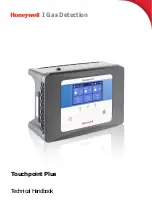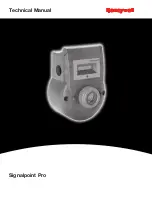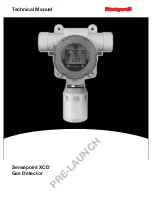
6
95-8676
3.1
INSTALLATION
Before installing the PointWatch Eclipse detector,
define the following application details:
WIRING
The detector must be installed per local installation
practices. For IEC/ATEX hazardous areas, it may be
acceptable to utilize Ex e wiring practices with the
PIRECL (non-relay versions).
IDENTIFICATION OF DETECTOR MOUNTING
LOCATIONS
Identification of the most likely leak sources and leak
accumulation areas is typically the first step in identifying
the best detector mounting locations. In addition,
identification of air current / wind patterns within the
protected area is useful in predicting gas leak dispersion
behavior. This information should be used to identify
optimum sensor installation points.
Because CO
2
is heavier than air, the sensor should be
placed close to the floor for optimal detection. Note that
air currents may cause CO
2
gases to rise under some
conditions. Heated gases may also exhibit the same
phenomenon.
The most effective number and placement of detectors
varies depending on the conditions at the job site. The
individual designing the installation must often rely on
experience and common sense to determine the detector
quantity and best locations to adequately protect the
area. Note that it is typically advantageous to locate
detectors where they are accessible for maintenance,
and also where the Eclipse status indication LED can
easily be seen. Locations near excessive heat / vibration
sources should be avoided if possible.
Final suitability of possible gas detector locations should
be verified by a job site survey. Gas detector area of
coverage is a subjective evaluation, and may require
long-term empirical data to confirm effectiveness. A
typical rule of thumb is that one detector can cover a 900
square foot area.
However, this rule of thumb is subject to change
depending upon specific application properties and
requirements.
NOTE
For additional information on determining the
quantity and placement of gas detectors in a
specific application, refer to the IEC 60079-29-2
standard.
PHYSICAL INSTALLATION REQUIREMENTS
The detector is provided with built-in mounting feet
that will accept 3/8 inch (M8) diameter mounting bolts.
Always ensure that the mounting surface is vibration-free
and can suitably support the total weight of the detector
without assistance from electrical cabling or conduit
system.
The detector must be installed per local installation
practices. For IEC/ATEX hazardous areas, it may be
acceptable to utilize Ex e wiring practices with the
Eclipse.
Device Mounting Orientation
It is highly recommended that the Eclipse be installed
in the horizontal position.
The detector is not position-
sensitive in terms of its ability to detect gas. However, the
weather baffle assembly provides superior performance
when the Eclipse is installed with the baffle in a horizontal
position.
LED Visibility
Select a mounting orientation where the PIRECL status
indication LED is visible to personnel within the area.
CORRECT
INCORRECT
Recommended Orientation of Eclipse Detector









































